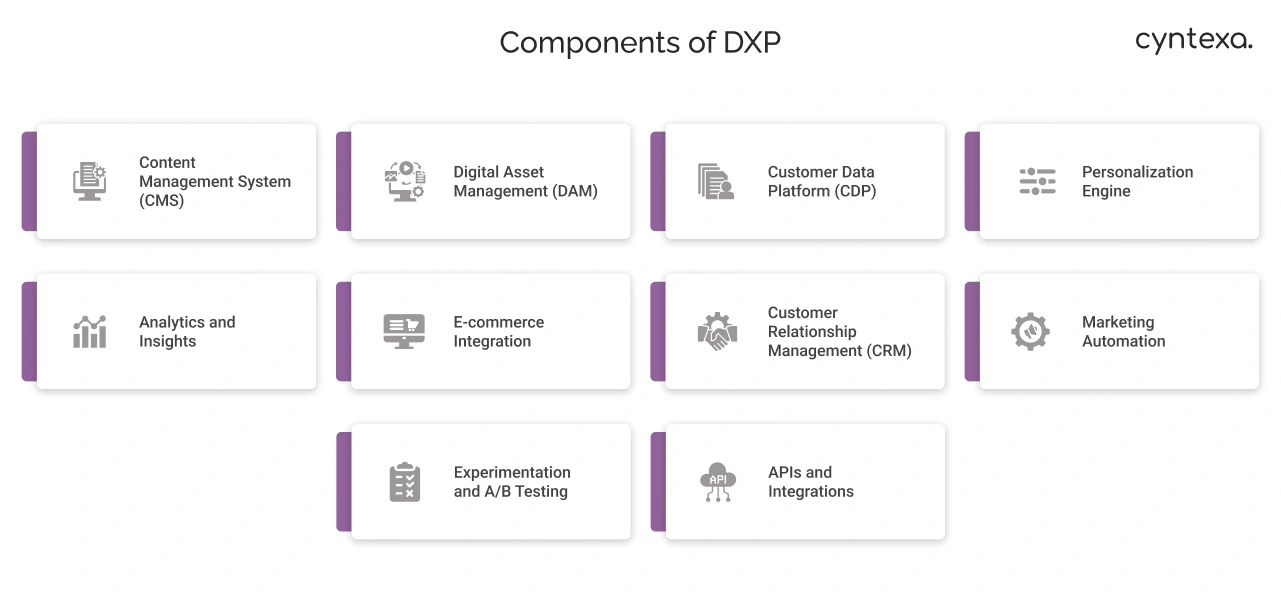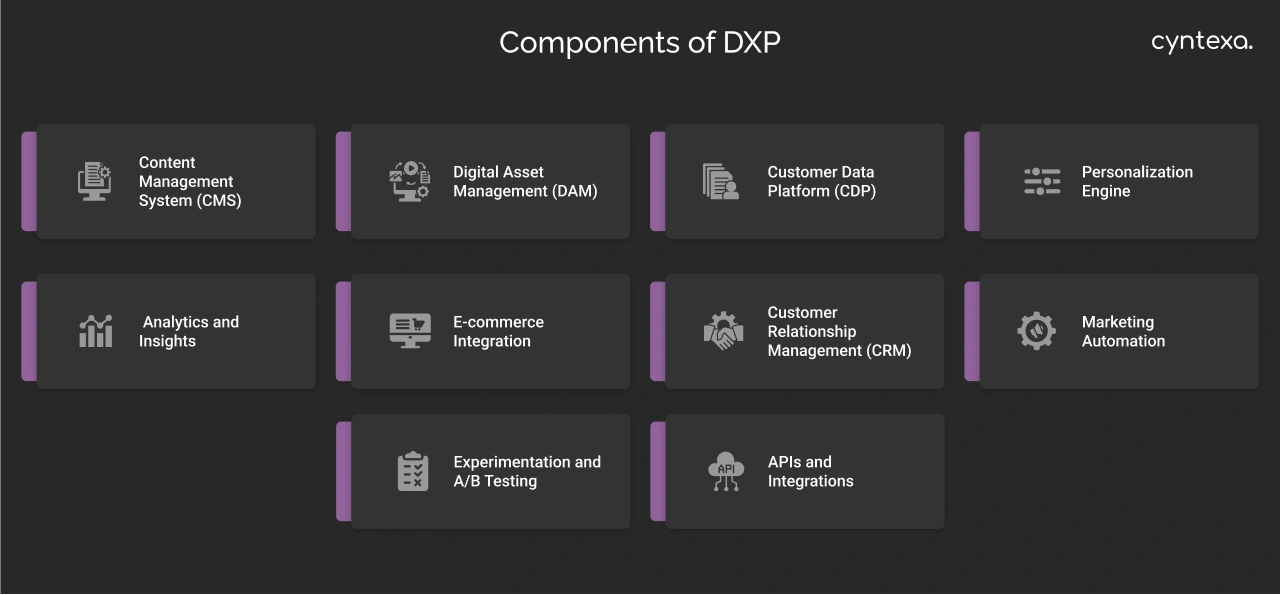What Is a Digital Experience Platform (DXP)? A Complete Guide
Table of Contents
What is a Digital Experience Platform (DXP)?
A Digital Experience Platform (DXP) is a connected suite of technologies designed to create, manage, deliver, and optimize personalized customer experiences across various digital touchpoints. It serves as a centralized hub allowing teams to create seamless and consistent interactions throughout the journey, be it from websites, mobile apps, portals or other digital channels.
Key Features of a DXP:
- Content Management: Facilitates the creation, organization, and distribution of digital content across websites, mobile apps, and other platforms.
- Personalization: Delivers tailored experiences by analyzing user behavior and preferences, enhancing engagement and satisfaction.
- Analytics: Provides insights into user interactions and content performance, supporting data-driven decision-making.
- Integration Capabilities: Connects with existing systems such as CRM, ERP, and marketing automation tools, ensuring a cohesive digital ecosystem.
By connecting functionalities like content management, customer data integration & unification, personalization and analytics. DXP empower businesses to deliver relevant and engaging experiences tailored to individual user needs. The unification makes management of digital content and customer interactions, enhancing engagement and building brand loyalty.
In an era where customer expectations are constantly growing, DXPs play a crucial role in enabling organizations to adapt swiftly, ensuring that digital experiences remain cohesive, responsive, and aligned with user preferences across all platforms.
To better understand how these platforms fit into a broader strategy, explore what is digital experience and why it matters in today’s customer-centric landscape.
How is DXP different from CMS?
A Digital Experience Platform (DXP) and a Content Management System (CMS) both play roles in managing digital content, but they differ significantly in scope and functionality. Before we get into their differences, let’s explore what is a Content Management System (CMS)?


Understanding CMS: A Focus on Content Management System
A CMS is designed to create, publish, organize and manage digital content, typically for websites. It allows users, mostly with less or no technical expertise, to oversee content creation and editing through user-friendly interfaces. Its features commonly include content editing tools, media management, and basic workflow capabilities.
CMS platforms are ideal for teams looking for a straightforward solution to manage their website content efficiently.
Key Differences Between CMS and DXP
Here is what makes a Digital Experience Platform different from a Content Management System:
- Scope of Functionality:
While a CMS solely focuses on creating content and its publication, a Digital Experience Platform offers a wide range of capabilities, including customer engagement, personalization, and data-driven decision-making.
- Integration Capabilities:
DXPs are designed in a way that it easily gets integrated with various enterprise systems, facilitating a unified digital ecosystem. On the other hand, CMS platforms may offer limited integration options, requiring help from a seasoned IT consultant for planning and strategizing additional customization.
- Personalization and Analytics:
Most of the DXPs offer advanced tools for analyzing user behavior and delivering personalized content, enhancing user engagement and satisfaction. In contrast, CMS platforms typically offer basic analytics and limited personalization features.
- Omnichannel Delivery:
DXPs support content delivery across multiple channels, including web, mobile, social media, and IoT devices, ensuring a consistent user experience. CMS platforms are generally web-centric, focusing on website content management.
Components of DXP


A DXP is commonly made up of certain components. Each component plays an important role in ensuring a seamless and engaging customer journey. Here’s an overview of the essential components of a DXP and how they contribute to delivering exceptional customer experiences:
1. Content Management System (CMS)
CMS lies in the core of DXP. It is responsible for creating, managing and publishing digital content. Modern-day DXPs often provide a headless CRM architecture, enabling teams to create content once and deliver it across multiple channels including website, mobile apps, and IoT devices. This keeps the intent of messaging and branding across all customer touchpoints the same.
2. Digital Asset Management (DAM)
DAM or Digital Asset Management system helps with management of digital assets like images, videos and documents. By organizing these assets centrally, teams can easily access and deploy them to various platforms. This helps in maintaining brand consistency and faster time-to-market for campaigns.
3. Customer Data Platform (CDP)
A Customer Data Platform collects, stores and unifies customer data from multiple sources and creates unified customer profiles. With a comprehensive view, businesses can decode customer behavior and preferences, facilitating personalized marketing strategies and improving the overall customer experience.
4. Personalization Engine
Now, data stored in CDP assists personalization engines in tailoring content and experiences to individual users. You can easily experience an increase in customer engagement, satisfaction score and conversion rates, once your CDP starts delivering relevant content based on user behavior and preferences.
5. Analytics and Insights
What good a Customer Experience platform is without analytics tools? Nothing. Analytics tools within a DXP allow users to track and analyze customer interactions, activities, behavior, and predict trends across all digital touchpoints. These insights are also useful in measuring campaign effectiveness, and make data-driven decisions to optimize the customer experience for a longer run.
6. E-commerce Integration
If your business is getting the majority of sales from selling online, integrating an eCommerce platform can add so much value to your DXP. This includes managing product catalogs, processing transactions, and handling customer orders, all within a unified platform to provide a seamless shopping experience.
7. Customer Relationship Management (CRM)
A CRM system within a Digital Experience platform manages customer interactions and data throughout the customer lifecycle. By keeping track of communication and transactions, businesses can nurture relationships, improve customer retention and drive sales growth.
8. Marketing Automation
While we talk about offering an ultimate customer experience, how can we forget Marketing? Marketing automation tools streamline repetitive tasks such as email campaigns, social media posting and ad management. By automating these processes, businesses can provide timely and consistent communication with customers, enhancing engagement and efficiency.
9. Experimentation and A/B Testing
DXPs often include tools for experimentation, allowing businesses to test different versions of content or user interfaces. By analyzing performance metrics, companies can determine the most effective strategies to enhance user engagement and conversion rates.
10. APIs and Integrations
A robust DXP offers extensive API capabilities, enabling seamless integration with various third-party tools and systems. This flexibility allows businesses to customize their digital ecosystem, ensuring all components work harmoniously to deliver optimal customer experiences.


Types of Digital Experience Platforms
Digital Experience Platforms (DXPs) come in various architectures and specializations, each tailored to meet specific business needs and technological preferences. Understanding these distinctions is crucial for organizations aiming to deliver seamless and personalized digital experiences.


1. Open Digital Experience Platform
An Open DXP is like a digital playground for modern enterprises. It gives businesses the freedom to build their own digital experience architecture by integrating third-party tools and services of their choice. From CRM and CMS to personalization engines and data lakes, all components are connected through APIs to form a tailored ecosystem.
This model supports a best-of-breed approach, enabling organizations to adapt quickly to new technologies without being locked into a single vendor. Open DXPs suit digitally mature businesses with strong in-house development teams. While implementation can require more integration work upfront, the long-term payoff is agility, innovation, and complete architectural control.
This type of digital experience platform is ideal for large or fast-scaling businesses seeking high customization and integration capabilities.
2. Closed Digital Experience Platform
A Closed DXP takes a different path. It offers an entirely integrated suite of tools which is hosted and managed by a single vendor. Everything from CMS and analytics to personalization and marketing automation is pre-package, pre-integrated and readily-optimized to enable you to get started easily.
This platform is perfect for businesses seeking fast and consistent rollout without having to deal with complexity of integrating multiple systems. Now what is the restriction here: limited vendor’s roadmap, feature set, and extensibility. The bright side: mid-sized companies or regulated industries can still pull this off as the simplicity and vendor accountability outweigh the flexibility limitations.
3. Composable Digital Experience Platform
Composable Digital Experience Platforms are the most modern and modular types. Most of them follow a “build your own type” concept, allowing businesses to choose and assemble the individual parts of their digital experience stack.
Let’s understand this with an example. Suppose you are using Salesforce as your core CRM and you need assistance with unified data, real-time analytics and smart insights, personalization at its core, marketing automation, a full-fledged loyalty management system and anything else your strategy demands. Now, the first action most professionals think of is third-party integrations, which can work but till when.
Salesforce itself offers its natively-built/hosted solutions to cater this requirement:
- For sorting and unification of data, you can rely on Salesforce Data Cloud.
- For personalized marketing automation, Salesforce Marketing Cloud has a history of delivering expected results.
- For building and managing loyalty among customers, no other platform can outshine Salesforce Loyalty Management.
- And for real-time analytics and smart insights, Salesforce Einstein is assisting businesses across industries and empowering them to make data-driven decisions.
Individually, these are powerful tools. Together, they form a flexible, future-ready experience stack one that evolves with your strategy, not against it.
Everyone loves the idea of plug-and-play. But without proper planning, modularity turns into mayhem. That’s where Salesforce consulting services quietly do the heavy lifting bringing order, not chaos, to your stack.
Based on MACH architecture (Microservices-based, API-first, Cloud-native, Headless), composable DXPs allow every component to evolve independently. Teams can test, swap, or scale functionalities without affecting the entire system. This kind is best suited for enterprises prioritizing innovation, scale, and speed-to-experiment in their customer experience strategy.


4. Monolithic Digital Experience Platform
If you are looking for a one tightly integrated platform with a full set of digital experience tools, A Monolithic DXP delivers it precisely. You get content management, customer data, marketing automation, personalization, analytics and sometimes even eCommerce from one vendor and in one single contract.
Monolithic DXP rules out integration challenges, streamlines operations, and ensures consistency across digital touchpoints. Although it is less flexible of an option compared to an open or composable model, Monolithic DXP is easier to deploy and maintain, particularly for businesses needing less technical complications.
5. Headless DXP
A Headless DXP separates the backend, where content is created and stored, from the frontend, where it’s displayed to users. This separation gives businesses more flexibility to deliver content across different channels using APIs.
In simple terms, once your content is ready, it can be shared anywhere your website, mobile app, smartwatch, in-store kiosk, or even a VR headset without needing to recreate it for each platform.
For developers, this means more freedom to design modern interfaces using the frameworks they prefer. For marketers, it allows easier content management in one place, without being tied to rigid templates.
Headless DXPs are also highly scalable and work well with fast-changing tech environments.
Top 5 Digital Experience Platforms


Following are the top 5 digital experience platforms trusted by companies across the globe:
1. Adobe Experience Cloud
When the goal is to deliver personalized and consistent customer experience, Adobe Experience Cloud stands at the forefront. It offers a comprehensive suite of tools designed to help businesses manage, personalize and optimize customer experience.
Core Capabilities
- Adobe Experience Platform (AEP): It serves as the foundation by centralizing customer data from various sources, enabling real-time customer profiles for targeted marketing efforts. It facilitates:
- Data Collection & Ingestion: Aggregates data from web, mobile, and connected devices in real-time.
- Data Management & Unification: Standardizes and unifies data into comprehensive customer profiles.
- Governance & Privacy: Ensures data usage complies with privacy regulations like GDPR and CCPA.
- Insights & AI: Leverages AI to analyze customer behavior and predict future actions.
- Extensibility: Provides APIs for seamless integration with third-party applications.
- Adobe Journey Optimizer: This tool enables businesses to identify high-impact opportunities and optimize omnichannel performance, enhancing customer engagement strategies.
- Adobe Experience Manager (AEM): A robust content management system that allows businesses to create, manage, and deliver personalized content across web, mobile, and other channels.
- Adobe Real-Time Customer Data Platform (CDP): Builds unified customer profiles by aggregating data from various sources, enabling personalized experiences at scale.
- Adobe Customer Journey Analytics: Provides deep insights into customer interactions across channels, helping businesses understand and optimize the customer journey.
- AI Agents: Introduced to assist brands in navigating consumer interactions, these agents tailor marketing efforts based on user activity, improving personalization and decision-making.
Adobe Experience Cloud is ideal for large enterprises with mature marketing technology stacks and high-volume content/personalization needs.
2. Salesforce Experience Cloud
Today’s customers move across devices and platforms without any interruptions and they expect your brand to keep up. Salesforce Experience Cloud gives you the exact tools to deliver unified, personalized experiences wherever your audience is.
As a Digital Experience platform, it allows businesses to create branded portals, forums, and websites for customers, partners, and employees. Built on the Salesforce Customer 360 platform, it ensures a unified approach to customer engagement by integrating data and processes across various departments.
Key Features and Capabilities
- Experience Builder: It is an intuitive drag-and-drop interface that empowers users to design and customize digital experiences without extensive coding knowledge. It offers pre-built templates and Lightning components to accelerate development.
- Mobile Publisher: With mobile publisher, you can transform Experience Cloud sites into fully branded mobile applications, ensuring consistent user experiences across devices. It also simplifies the process of publishing apps to app stores.
- Personalization Tools: Experience Cloud leverages user data to deliver tailored content and experiences through personalization tools, improve customer engagement and satisfaction rate.
- Gamification Elements: The platform supports gamified features such as badges, points systems, and leaderboards to increase user engagement. These elements encourage participation, reward community involvement, and help build long-term loyalty.
- Advanced Analytics and Reporting: Salesforce provides in-depth analytics that offer visibility into user behavior, content performance, and engagement trends. These insights help teams make data-driven decisions and continuously refine their digital experience strategy.
- Robust Security Measures: This platform ensures data protection through role-based access controls, secure authentication, and compliance with industry standards.
- Einstein AI: Einstein AI delivers predictive analytics and intelligent recommendations based on user behavior and data patterns. It enables marketers to personalize campaigns, improve content relevance, and drive better outcomes.
- Agentforce: Experience Cloud also tag along autonomous AI agents that can execute tasks such as customer support, data analysis, and workflow automation, thereby increasing efficiency and scalability.
Salesforce Experience Cloud is best suited for organizations willing to give a whole makeover to their customer experience strategy. However, to make sure this platform works as you want, it is recommended to rely on experts offering Salesforce Implementation services who make sure you are unlocking its true value.
3. Sitecore Experience Platform (XP)
As digital ecosystems become more complex, the need for a unified, intelligent platform is more important than ever. Sitecore XP delivers this through a powerful combination of CMS, analytics, marketing automation, and customer data capabilities. It empowers teams to manage omnichannel content, personalize experiences in real time, and scale their digital strategy with precision.
Core Capabilities
- Content Management: Sitecore XP offers content management features, allowing marketers to create and manage content efficiently. The platform supports multilingual content, version control, and workflow management, making sure consistency and compliance across all digital assets.
- Personalization: Leveraging real-time data, Sitecore XP delivers personalized experiences tailored to individual user behaviors and preferences. This dynamic personalization enhances customer engagement and drives conversions.
- Marketing Automation: The platform includes marketing automation tools that enable the creation of targeted campaigns, lead nurturing, and customer journey mapping. These tools streamline marketing efforts and improve ROI.
- Analytics and Insights: Sitecore XP provides comprehensive analytics, offering insights into customer behaviors, campaign performance, and content effectiveness. These insights inform data-driven decision-making and strategy refinement.
- Integration and Extensibility: With its open architecture, Sitecore XP integrates seamlessly with various third-party systems, including CRM, ERP, and e-commerce platforms. This flexibility ensures that businesses can tailor the platform to their specific needs.
- Sitecore Stream: This AI-driven feature assists marketers in content creation, ensuring consistency with brand voice and tone. It streamlines the content development process, reducing time-to-market.
Sitecore XP is best suited for medium to large enterprises seeking a robust and flexible DXP that can deliver personalized, data-driven experiences across multiple channels.
4. Oracle Customer Experience
Oracle CX is an integrated platform that combines customer data, AI-driven insights, and a suite of applications to empower businesses in creating meaningful customer engagements. It encompasses tools for marketing, sales, service, and commerce, all unified by the Oracle Fusion Cloud Applications Suite.
Core Capabilities
- Unified Customer Data: Oracle CX centralizes customer data from various sources, enabling real-time customer profiles for targeted marketing efforts. This unified view ensures consistency and relevance across all customer interactions.
- AI-Driven Insights: Leveraging AI and machine learning, Oracle CX provides predictive analytics and personalized recommendations, enhancing decision-making and customer engagement strategies.
- Marketing Automation: The platform offers robust marketing tools that automate campaign management, lead nurturing, and customer segmentation, driving efficiency and effectiveness in marketing efforts.
- Sales Enablement: Oracle CX equips sales teams with tools for opportunity management, forecasting, and customer insights, facilitating informed decision-making and improved sales performance.
- Customer Service Excellence: With features like AI-powered chatbots and knowledge management systems, Oracle CX enhances customer support, ensuring timely and accurate responses to customer inquiries.
- Commerce Integration: The platform seamlessly integrates with e-commerce systems, enabling personalized shopping experiences and streamlined order management processes.
Oracle Customer Experience (CX) is ideal for large enterprises with mature marketing technology stacks and high-volume content/personalization needs.
5. SAP Customer Experience (CX) Suite
SAP Customer Experience (CX) Suite is an integrated platform that combines customer data, AI-driven insights, and a suite of applications to empower businesses in creating meaningful customer engagements. It encompasses tools for marketing, sales, service, and commerce, all unified by the SAP Business Technology Platform (BTP).
Core Capabilities
- Unified Customer Data: SAP CX centralizes customer data from various sources, enabling real-time customer profiles for targeted marketing efforts. This unified view ensures consistency and relevance across all customer interactions.
- AI-Driven Insights: Leveraging AI and machine learning, SAP CX provides predictive analytics and personalized recommendations, enhancing decision-making and customer engagement strategies.
- Marketing Automation: The platform offers robust marketing tools that automate campaign management, lead nurturing, and customer segmentation, driving efficiency and effectiveness in marketing efforts.
- Sales Enablement: SAP CX equips sales teams with tools for opportunity management, forecasting, and customer insights, facilitating informed decision-making and improved sales performance.
- Customer Service Excellence: With features like AI-powered chatbots and knowledge management systems, SAP CX enhances customer support, ensuring timely and accurate responses to customer inquiries.
- Commerce Integration: The platform seamlessly integrates with e-commerce systems, enabling personalized shopping experiences and streamlined order management processes.
- AI Agents: Introduced to assist brands in navigating consumer interactions, these agents tailor marketing efforts based on user activity, improving personalization and decision-making.
SAP Customer Experience (CX) Suite is ideal for large enterprises with mature marketing technology stacks and high-volume content/personalization needs.
Top Benefits of Digital Experience Platforms


Here’s how a Digital Experience Platform helps businesses turn fragmented digital efforts into seamless, customer-first experiences:
1. Unified Customer View
A digital experience platform assembles data from different sources including CRM, website, social media, and support systems and brings it all into one place. This gives teams working across departments a complete view of each customer, allowing them to understand who they are, how they engage and what they need. With this clarity, it’s easier to tailor your communication and offer more relevant experiences.
2. Personalized Experiences at Scale
A lot of DX platforms come in with built-in AI and machine learning which assists in delivering personalized experiences to each customer based on their behavior and preferences. Whether it’s suggesting a product, sending a tailored email, or updating a homepage banner, personalization becomes easy to manage no matter how many customers you’re dealing with.
3. Omnichannel Consistency
If your brand is present online, then your audience is also across different touchpoints like websites, social media, other platforms and mobile apps. And with each touchpoint, they expect consistent experience tailored to the platform. A DXP helps ensure that your content, messaging, and branding remain aligned across all touchpoints, giving your audience a seamless and unified journey.
4. Enhanced Agility and Scalability
With a modular and composable setup, DXPs make it simple to adjust your digital tools as your business grows. You can easily add new features, test updates, or integrate third-party tools without disrupting existing systems. This makes it easier to stay agile and respond quickly to changing customer expectations or market trends.
5. Improved Collaboration and Efficiency
Because everything from content creation to data tracking happens within one connected system, it allows different teams (marketing, IT, sales, support) to collaborate more efficiently. This reduces duplicate work, speeds up content approvals, and ensures a more streamlined workflow across departments.
6. Advanced Analytics and Insights
These platforms also offer built-in analytics and reporting tools that help you understand what’s working and what’s not. You can track customer engagement, campaign performance, and content effectiveness in real time. These insights support better decision-making and continuous improvement across your digital channels.
7. Future-Proofing Digital Strategies
DXPs are built to adapt. Whether your strategy involves launching new microsites, exploring voice-enabled search, or integrating AR/VR experiences, these platforms offer the flexibility to support emerging technologies. This future-readiness helps your brand stay competitive and innovative.
How to Choose the Right Digital Experience Platform (DXP) for Your Business
While a DX platform promises to unify customer experience, it is important to choose the right platform that can truly add value in your digital transformation journey.
Here’ are some questions you must ask before selecting a digital experience platform for your business:
1. Does it truly align with your business goals or just your wishlist?
Start by aligning the required teams and define your business objectives. Are you aiming to enhance customer engagement, streamline operations, or expand into new markets? Your chosen DXP must support and align with these objectives.
However, be cautious of platforms that offer a plethora of features but don’t directly contribute to your specific goals. A feature-rich platform isn’t beneficial if it doesn’t serve your unique business needs.
2. Have you calculated the total cost of ownership or just the sticker price?
There is a lot more that counts beyond initial licensing fees. How about you consider long-term costs like implementation, maintenance, training and potential upgrades? Assess and evaluate the total cost of ownership to be sure on how much you are expected to invest in DXP.
Many vendors may downplay hidden costs. Brainstorm well to uncover expenses related to customization, third-party integrations, or scaling operations and then shortlist it.
3. Will it integrate seamlessly with your existing systems or create new silos?
Make sure the digital-first platform you are considering is fulfilling the bare minimum requirements like integration with existing systems like CRM, ERP and marketing automation tools, allowing you to manage data in real-time and provide consistent and quality experiences to customers.
4. Can it deliver genuine personalization or just generic experiences?
One of the core ways of creating a wholesome customer experience is through real-time personalization. Make sure your preferred platform supports consistent delivery of content on different channels. Assess whether the personalization features are genuinely effective or merely superficial. Test the platform’s ability to deliver meaningful, data-driven personalization.
5. Is it scalable and flexible or rigid and limiting?
Choose a DXP that can grow with your business, handling increasing traffic and content volumes without compromising performance.
Some platforms may scale technically but not operationally. Evaluate whether the platform can adapt to evolving business models and market demands.
6. Does it provide actionable insights or just data overload?
Advanced analytics tools are essential for understanding customer behavior and optimizing digital strategies. Look for platforms that offer actionable insights. Data overload can be counterproductive. Ensure that the platform provides clear, actionable insights rather than overwhelming dashboards.
7. Does it prioritize security and compliance or leave you exposed?
Data security and compliance with regulations like GDPR are non-negotiable. The DXP should offer robust security features, including data encryption and user authentication mechanisms. Don’t assume compliance; verify it. Request documentation and certifications to confirm the platform meets necessary security standards.
8. Is the vendor reliable and supportive or just a sales pitch?
Research the vendor’s track record, customer reviews, and support services. A reliable vendor should offer ongoing support, regular updates, and a clear product roadmap. A reputable brand doesn’t guarantee quality support. Investigate customer testimonials and case studies to assess the vendor’s commitment to client success.
9. What do real users say and are their experiences relevant to you?
Consult independent reviews and case studies to gain insights into the platform’s real-world performance.
Be cautious of cherry-picked success stories. Seek out diverse perspectives, including critical reviews, to gain a balanced understanding of the platform’s capabilities.
Choosing the right DXP requires a balance between ambition and pragmatism. While it’s tempting to opt for platforms luring through extensive features and capabilities, it’s crucial to ensure that these align with your specific business needs and objectives.


Buying the Best Platform Won’t Save You But Execution Will
Let’s cut through the noise. Every DXP claims to be the most flexible, scalable, intelligent platform out there. And on paper? Many of them are. But here’s what rarely gets said out loud: most DXP failures don’t happen because the platform lacked features. They happen because businesses expect the tech to do the thinking for them.
The truth is, choosing the right DXP isn’t a matter of checking off product sheets. It’s about deeply understanding your architecture, your customer journey, and operational gaps and then selecting and stitching together the components that actually support them.
That kind of execution requires more than just IT support. It calls for deep IT consulting services that tags along the team of experts who understands platform architecture, builds cross-cloud experiences, and anticipates real-world complexity before it becomes a blocker. That’s exactly what Cyntexa offers as your Digital transformation partner; a real advantage by working with business seeking guidance for platform-driven digital experience strategy and implementation expertise together under one roof.
Because in the DXP game, your platform is only as strong as the people who design, implement, and evolve it with you.
Don’t Worry, We Got You Covered!
Get The Expert curated eGuide straight to your inbox and get going with the Salesforce Excellence.
AUTHOR
Jagrat
AppExchange, Salesforce Community Cloud, Loyalty Cloud
Jargrat, Delivery Manager at Cyntexa, has 7+ years of experience in the Salesforce ecosystem. He specializes in Salesforce AppExchange, Community (Experience) Cloud, and Loyalty Management, Jagrat excels in building scalable, customer-centric platforms that foster engagement, loyalty, and seamless digital experiences for businesses.


Cyntexa.
Join Our Newsletter. Get Your Daily Dose Of Search Know-How









